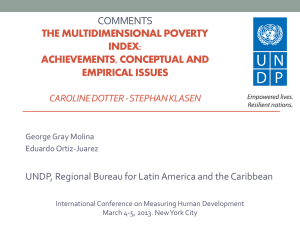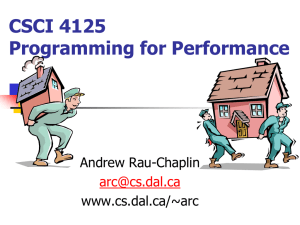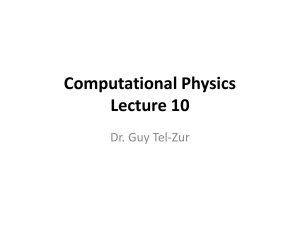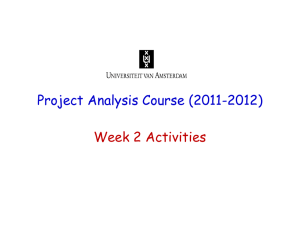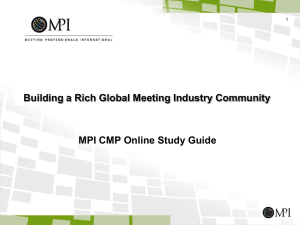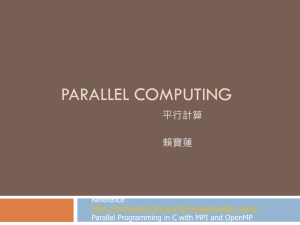A High-Level Framework for Parallelizing Legacy
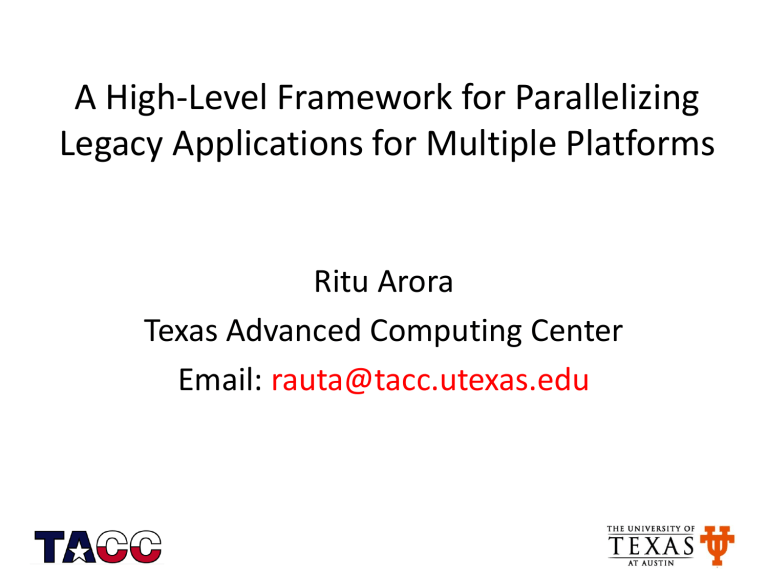
A High-Level Framework for Parallelizing
Legacy Applications for Multiple Platforms
Ritu Arora
Texas Advanced Computing Center
Email: rauta@tacc.utexas.edu
Outline
• Motivation and Goals
• Overview of the Framework with demos
• Results
• Features and Benefits
• Project Status
• Future Work
• Conclusion
• Q & A
2
Plenty of Parallel Programming Languages and Paradigms
MPI
OpenMP
CUDA
OpenCL
Implicitly Parallel Languages (X10, Fortress, SISAL)
PGAS languages (UPC, Co-Array Fortran)
Offload programming for MIC
SHMEM
Cilk/Intel Cilk Plus
Charm++
HPF
Hybrid programming (MPI + OpenMP)
3
There is a need to develop a tool (high-level framework) that offers a low-risk way for domain-experts to try HPC but first…
4
… Understanding the Mindset of the User
Community is Important
“…the history of HPC is littered with new technologies that promised increased scientific productivity but are no longer available.”
“A new technology that can coexist with older ones has a greater chance of success than one requiring complete buy-in at the beginning.”
“For many frameworks, a significant barrier to their use is that you can’t integrate them incrementally.”
“Frameworks provide programmers a higher level of abstraction, but at the cost of adopting the framework’s perspective on how to structure the code.”
Source: Understanding the High Performance Computing Community: A Software Engineer’s Perspective,
Basili et al.
5
Standard and Non-Standard Steps for
Parallelization that are Repeatable
• Examples of standard steps in developing an MPI application (common in all MPI programs)
– Every MPI program has #include "mpi.h"
– Every MPI program has MPI_Init and
MPI_Finalize function calls
• Non-standard steps in developing an MPI application
– for-loop parallelization, data distribution, mapping of tasks to processes, and orchestration of exchange of messages
• Steps for splitting the work in a for-loop amongst all the processes in MPI_COMM_WORLD are standard for a given load-balancing scheme
6
Goals
• Develop a high-level framework for semi-automatic parallelization that can leverage the investment made in legacy applications
• The framework should be built on top of successful programming paradigms like MPI, OpenMP, and CUDA
• Provide support for incremental parallelism through the framework
• Abstract the standard and non-standard steps in parallelization
7
Outline
• Motivation and Goals
• Overview of the Framework with demos
• Results
• Features and Benefits
• Project Status
• Future Work
• Conclusion
• Q & A
8
How Does the Framework Work?
9
Providing Specifications Through Hi-PaL (1)
Parallel section begins <hook type> ( < hook pattern > ) mapping is < mapping type > {
< Hi-PaL API for specifying the operation> < hook > &&
} in function (<function name>)
General Structure of Hi-PaL Code to Generate MPI Code
OMP_Parallel {
< Hi-PaL API for specifying the operation> && schedule is
< schedule type > < hook > && in function (<function name>)
}
General Structure of Hi-PaL Code to Generate OpenMP Code
10
Providing Specifications Through Hi-PaL (2)
A set of Hi-PaL API has been developed for precisely capturing the end-users’ specifications at a high-level
Hi-PaL API
ParExchange2DArrayInt(<array name>, <num of rows>, <num of columns>)
Description
Exchange neighboring values in stencil-based computations
Parallelize_For_Loop where
(<for_init_stmt>;
<condition>; <stride>)
Parallelize for-loop with matching condition, stride and initialization statement
ReduceSumInt(<variable name>)
MPI_Reduce with MPI_SUM operation or OpenMP reduction clause with ‘+’ operator; reduced variable is of type integer
11
Parallelizing Poisson solver (1)
1. //other code
2. NTIMES = atoi(argv[3]);
3. a = allocMatrix<double>(a, M, N);
4. b = allocMatrix<double>(b, M, N);
5. f = allocMatrix<double>(f, M, N);
6. start = 0;
7. //other code
8. printMatrix<double>(a, M, N);
9. t1 = gettime();
10. for (k = start; k < NTIMES && norm >= tolerance; k++) {
11. b = compute(a, f, b, M, N);
12. ptr = a;
13. a = b;
14. b = ptr;
15. norm = normdiff(b, a, M, N);
16. }
17. t2 = gettime();//other code
Code snippet of serial Poisson Solver Code
12
Parallelizing Poisson solver (2)
1.
Parallel section begins after ( "NTIMES = atoi(argv[3]);" ) mapping is Linear {
2.
ParExchange2DArrayDouble ( a , M , N ) before statement
( "printMatrix<double>(a, M, N);" )
&& in function ( "main" );
3.
ParExchange2DArrayDouble ( b , M , N ) before statement
( "printMatrix<double>(a, M, N);" )
&& in function ( "main" );
4.
ParExchange2DArrayDouble ( b , M , N ) after statement
( "b=compute(a, f, b, M, N);" ) && in function ( "main" );
5.
AllReduceSumInt( norm ) after statement
( "norm = normdiff(b, a, M, N);" ) && in function ( "main" )
6.
}
Hi-PaL Code to Generate MPI Code for Poisson Solver
13
Generated MPI Code for Poisson Solver (1)
1. //other code
2. NTIMES = atoi(argv[3]);
3. MPI_Init(NULL, NULL);
4. MPI_Comm_size(MPI_COMM_WORLD, &size_Fraspa);
5. MPI_Comm_rank(MPI_COMM_WORLD, &rank_Fraspa);
6. create_2dgrid(MPI_COMM_WORLD, &comm2d_Fraspa,…);
7. create_diagcomm(MPI_COMM_WORLD, size_Fraspa, …);
8. rowmap_Fraspa.init(M, P_Fraspa, p_Fraspa);
9. colmap_Fraspa.init(N, Q_Fraspa, q_Fraspa);
10. myrows_Fraspa = rowmap_Fraspa.getMyCount();
11. mycols_Fraspa = colmap_Fraspa.getMyCount();
12. M_Fraspa = M;
13. N_Fraspa = N;
14. M = myrows_Fraspa;
15. N = mycols_Fraspa;
16. a = allocMatrix<double>(a, M, N);
14
Generated MPI Code for Poisson Solver (2)
17. b = allocMatrix<double>(b, M, N);
18. f = allocMatrix<double>(f, M, N);
19. start = 0;
20. //other code
21. a = exchange<double>(a, myrows_Fraspa + 2, …);
22. b = exchange<double>(b, myrows_Fraspa + 2, …);
23. printMatrix<double>(a, M, N);
24. t1 = MPI_Wtime();
25. for (k = start; k < NTIMES && norm >= tolerance; k++) {
26. b = compute(a, f, b, M, N);
27. b = exchange<double>(b, myrows_Fraspa + 2, …);
28. ptr = a;
29. a = b;
30. b = ptr;
31. norm = normdiff(b, a, M, N);
32. MPI_Allreduce(&norm, &norm_Fraspa, 1, MPI_INT, MPI_SUM,…);
33. norm = norm_Fraspa;
34. }
36. //other code
15
Snippet of Exchange Template for MPI template <typename T>
T** exchange(T** data, int nrows, int ncols, int P, int Q, int p, int q, MPI_Comm comm2d, MPI_Comm rowcomm, MPI_Comm colcomm) {
//other code above. Create datatype for the recvtype code below
MPI_Type_vector(nrows-2, 1, ncols, datatype, &temptype);
MPI_Type_extent(datatype, &sizeoftype) ; int blens[2] = {1, 1};
MPI_Aint displ[2] = {0, sizeoftype};
MPI_Datatype types[2] = {temptype, MPI_UB};
MPI_Type_struct (2, blens, displ, types, &vectype);
MPI_Type_commit(&vectype);
MPI_Cart_shift(rowcomm, 0, -1, &prev, &next);
MPI_Cart_shift(colcomm, 0, -1, &down, &up);
// send and receive the boundary rows
MPI_Irecv(&data[0][1], ncols-2, datatype, up, 0, …);
MPI_Irecv(&data[nrows-1][1], ncols-2, datatype, down, 0, …);
MPI_Isend(&data[1][1], ncols-2, datatype, up, 0, colcomm, …);
MPI_Isend(&data[nrows-2][1], ncols-2, datatype, down, …);
…}
16
Providing the Specifications Through Command-Line Interface
Would you like to use MPI or OpenMP?
(1) MPI
(2) OpenMP
2
==================================================
Would you like to use MIC?
(1) Yes
(2) No
1
==================================================
Would you like to use this for loop? Y or N? for ( i = 0; i < ihi; i++ ){ i4_to_bvec ( i, n, bvec ); value = circuit_value (n, bvec);
... //other lines of code
}
Y
This loop contains the following variables: i,value,j,solution_num
Choose the variables for reduction: solution_num
17
Operation Complete...OpenMP code with offload capability is generated
Providing the Specifications Through
Graphical User Interface
18
Currently Available Support For…
Parallel Programming
Paradigms
MPI
OpenMP
MPI +
OpenMP
OpenMP
+ Offload
Parallel
Programming
Patterns
For-loops with
Reduction
Stencil-Based
Computations
(Regular Mesh)
Pipeline
Base languages supported
C/C++
Support for
Fortran will be added …
Replicable
CUDA
19
Time for demos
• Using the framework through GUI
• Using the framework through Hi-PaL
20
Outline
• Motivation and Goals
• Overview of the Framework with demos
• Results
• Features and Benefits
• Project Status
• Future Work
• Conclusion
• Q & A
21
Results: Poisson Solver (Hi-PaL based MPI)
22
Results: Genetic Algorithm for Content Based
Image Retrieval (Hi-PaL based MPI & OpenMP)
23
Results: Seismic Tomography Code (GUI-based
CUDA)
24
Results: Circuit Satisfiability Code (GUI-based
OpenMP + Offload)
25
Outline
• Motivation and Goals
• Overview of the Framework with demos
• Results
• Features and Benefits
• Project Status
• Future Work
• Conclusion
• Q & A
26
Summary of Features & Benefits of the
Framework
• Enhances the productivity of the end-users in terms of the reduction in the time and effort
– reduction in manual effort by over 90% while ensuring that the performance of the generated parallel code is within 5% of the sample hand-written parallel code
• Leverages the knowledge of expert parallel programmers
• Separates the sequential and parallel programming concerns while preserving the existing version of sequential applications
27
Outline
• Motivation and goals
• Overview of the Framework with demos
• Results
• Features and Benefits
• Project Status
• Future Work
• Conclusion
• Q & A
28
Project Status
29
Outline
• Motivation and goals
• Overview of the Framework with demos
• Results
• Features and Benefits
• Project Status
• Future Work
• Conclusion
• Q & A
30
Future Work
• Migrate from DMS to Rose source-to-source compiler and integrate all the interfaces
• Usability studies:
– Should be able to rank the user preferences for the interface
– Prioritize the development effort
• Integration with PerfExpert and Eclipse
• Ability to handle irregular meshes and specify pipeline mode of communication through GUI
• Address the demands for
– a directives-based interface
– the option of editing the log-file to repeat the codegeneration process without going through the GUI
31
Outline
• Motivation and goals
• Overview of the Framework with demos
• Results
• Features and Benefits
• Project Status
• Future Work
• Conclusion
• Q & A
32
Conclusion
• Through this research and development effort, we have demonstrated
– an approach for lowering the adoption barriers to HPC by raising the level of abstraction of parallel programming
– an interactive tool for teaching parallel programming: think
“Alice” and “DrJava”
– the usage of multiple interfaces to accommodate the preferences of the user-community: one size does not fit all
– that it is possible to achieve abstraction and performance at the same time
33
Acknowledgement
On behalf of my co-authors, student and XSEDE intern (Julio Olaya), I would like to thank NSF,
XSEDE and TACC!
34
Thanks for listening!
Any questions, comments or concerns?
Contact: rauta@tacc.utexas.edu
35

